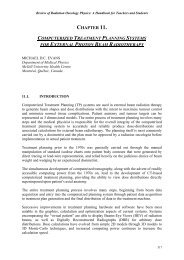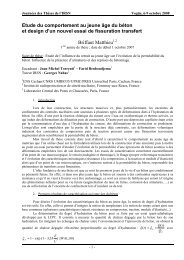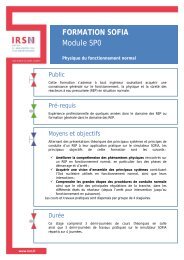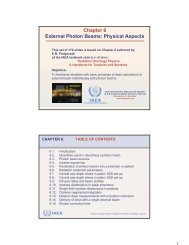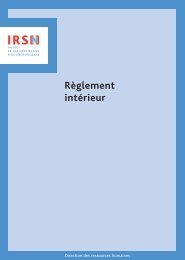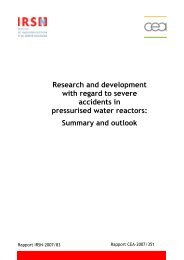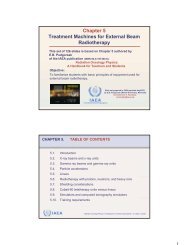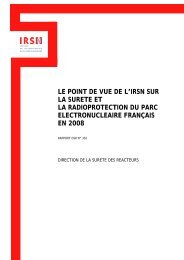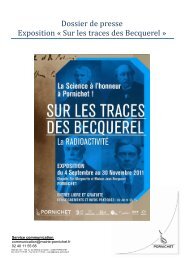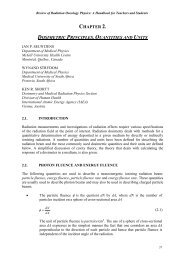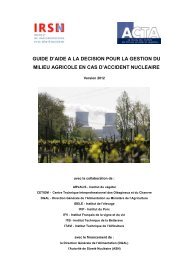Booklet radioecology - IRSN
Booklet radioecology - IRSN
Booklet radioecology - IRSN
You also want an ePaper? Increase the reach of your titles
YUMPU automatically turns print PDFs into web optimized ePapers that Google loves.
IPSN<br />
booklets<br />
INSTITUT DE PROTECTION ET DE SÛRETÉ NUCLÉAIRE<br />
Radioecology<br />
To know<br />
and understand<br />
the evolution<br />
of radioactivity<br />
in the environment.
The use of nuclear energy<br />
in both military<br />
and civil applications<br />
has led scientists to study<br />
the fate of radioactive products<br />
called "radionuclides" (see P. 21)<br />
released in the environment<br />
since the beginning<br />
of the 1940s.<br />
This concern has given birth<br />
to an ecological discipline - <strong>radioecology</strong>.<br />
Both natural and artificial<br />
radionuclides can be found<br />
throughout the environment.
All you need to know about <strong>radioecology</strong><br />
1<br />
What is <strong>radioecology</strong>?<br />
Radioecologists seek to understand the evolution of radionuclides in the environment<br />
and to collect data to predict their dosimetric impact.<br />
2<br />
Radioecology in the world and in France<br />
Studies on <strong>radioecology</strong> have been developed from 1940 up to the present day<br />
in parallel with military and civil nuclear activities.<br />
Origins of radionuclides<br />
3<br />
Weapons testing, accidents at facilities, controlled waste have released artificial radionuclides<br />
into the environment which are added to natural-occurring radionuclides.<br />
Radioecology tools<br />
4<br />
Measurements on samples taken in the field and laboratory work are the basis<br />
for development of software programmes used to predict dosimetric impact.<br />
Marine <strong>radioecology</strong><br />
5<br />
Radioecologists carry out assessments on the effects of dumping waste<br />
from nuclear facilities at sea.<br />
Radioecology of inland waters<br />
6<br />
Liquid radioactive waste produced by nuclear facilities located along rivers<br />
is discharged into fresh water.<br />
Land <strong>radioecology</strong><br />
7<br />
The radionuclides in the land ecosystem affect human health mainly through<br />
the food chain: plants animals meat or milk.<br />
8<br />
Radioecological studies in the field<br />
Around a nuclear power station - Radioactivity levels are regularly controlled in the different<br />
environments to measure the radioecological impact caused by waste from the power station.<br />
9<br />
Radioecological studies in the field<br />
The Nord-Cotentin Radioecology Group - In Nord-Cotentin, an inventory of radioactive<br />
waste from a fuel reprocessing plant was conducted.<br />
Mercantour workshop zone - In the Mercantour area, a "workshop zone" was created to trace<br />
the migration of the caesium-137 released in May 1986 after the Chernobyl accident.<br />
10<br />
A permanent observatory and instant information<br />
1
11<br />
What is <strong>radioecology</strong>?<br />
The purpose of <strong>radioecology</strong> is to detect the presence of<br />
radionuclides in the environment, to research their<br />
origins and to understand their process of transfer and<br />
their concentration in ecosystems.<br />
Its aim is to evaluate the impact of both natural and<br />
artificial radioactivity on the environment<br />
(radioecological impact) and on the population<br />
(dosimetric impact) (see P. 21). These studies are based<br />
on the same approach as those relating to other<br />
chemical polluting agents such as heavy metals (lead,<br />
zinc, etc.) or nitrates.<br />
Given the presence of radionuclides in all ecosystems<br />
and the complexity of the transfer processes,<br />
radioecologists work in three main environments in the<br />
biosphere: the marine aquatic environment, the inland<br />
aquatic environment and the land environment.<br />
From the picture …<br />
Air, land, water<br />
and living organisms,<br />
including human<br />
beings, make up<br />
the biosphere which<br />
can be subdivided<br />
into ecological units<br />
called "ecosystems".<br />
A river, a lake,<br />
an ocean, a mountain<br />
chain, a tropical forest,<br />
a town or a desert<br />
are ecosystems.<br />
Radionuclides are scattered into the air and water, settle<br />
on the soil and sediments, migrate into the food chains …<br />
and thus can affect man.<br />
transfers<br />
liquid effluents<br />
gas effluents<br />
breathing<br />
2<br />
nutrition<br />
meat - milk - vegetables
… to the model …<br />
The environment can be depicted by a series of boxes<br />
through which radionuclides circulate. Radioecologists<br />
seek to measure the concentration of the radionuclides in<br />
each box and understand their transfer mechanisms.<br />
Atmosphere<br />
Wet and dry deposits<br />
Sediments Soils<br />
Deposits Irrigation<br />
Water<br />
Drainage<br />
migration<br />
Root<br />
transfers<br />
Plants<br />
Nutrition<br />
Animals<br />
… to predict the dosimetric impact<br />
Radioecology provides data used in calculating the<br />
dosimetric impact. Whether the waste be controlled or<br />
accidental, <strong>radioecology</strong> helps provide answers to<br />
potential questions from public authorities, the nuclear<br />
industry, the media or the public at large.<br />
3
2<br />
Radioecology in the world and in France<br />
The term "<strong>radioecology</strong>" first appeared in 1935 but only<br />
became widely used during the 1950s. It probably<br />
emerged from the combination of "radioactivity" and<br />
"ecology". The first radioecological work was published<br />
in Geneva in 1955 during the first international meeting<br />
on the use of nuclear energy in the Pacific.<br />
Significant events<br />
in the world<br />
… and in France<br />
1940-1950 • First nuclear weapons tests • Divergence of ZOE reactor<br />
• Nuclear explosions at Hiroshima (Fontenay-aux-Roses - 1948)<br />
and Nagasaki<br />
• • • • • • • • • • • • • • • • • • • • • • • • • • • • • • • • • • • • • • • • • • • • • • •<br />
1950-1960 • Use of radionuclides in biology • Creation of an "ecology" group<br />
and agriculture<br />
at CEA<br />
• Kyshtym accident in the USSR<br />
• Beginning of scientific<br />
and at Windscale in Great Britain<br />
publications<br />
• • • • • • • • • • • • • • • • • • • • • • • • • • • • • • • • • • • • • • • • • • • • • • •<br />
1960-1970 • First international congress on • Creation of radioecological laboratories<br />
<strong>radioecology</strong> in the USA (1961)<br />
at CEA<br />
• Radioecology congress organised<br />
• First congress organised<br />
by Vienna Agency (IAEA – 1966) in France (Cadarache, 1969)<br />
• • • • • • • • • • • • • • • • • • • • • • • • • • • • • • • • • • • • • • • • • • • • • • •<br />
1970-1980 • Oil crisis, rise of nuclear energy • First reference states before<br />
• Accident at Three Mile Island<br />
installation of nuclear power<br />
in the USA<br />
stations (Bugey, Fessenheim)<br />
• • • • • • • • • • • • • • • • • • • • • • • • • • • • • • • • • • • • • • • • • • • • • • •<br />
1980-1990 • Accident at Chernobyl in Ukraine • Experimental studies<br />
(1986) on the effects of an accident<br />
on the environment: RESSAC<br />
programme (Cadarache)<br />
• • • • • • • • • • • • • • • • • • • • • • • • • • • • • • • • • • • • • • • • • • • • • • •<br />
1990-2001 • Development of studies • Study of the impact<br />
on the storage of radioactive waste<br />
of the Chernobyl accident<br />
(Vosges, Mercantour, Corsica)<br />
4
The two main public bodies involved in the field of<br />
<strong>radioecology</strong> in France are IPSN and OPRI (Office de<br />
protection contre les rayonnements ionisants). IPSN<br />
carries out radioecological studies in the framework of its<br />
activities in research and assessment. Its department for<br />
the protection of the environment is organised around<br />
themes of study and has several sites.<br />
La Hague<br />
Octeville<br />
Le Vésinet<br />
Saclay<br />
Angers<br />
Fontenay-aux-Roses<br />
Orsay<br />
•Radioecological studies<br />
on the Atlantic seaboard<br />
•Experimental <strong>radioecology</strong><br />
•Modelling and validation of transfers<br />
of radionuclides in the environment<br />
•Organisation of environmental data<br />
Agen<br />
Avignon<br />
Cadarache<br />
Toulon<br />
•Studies and intervention relating<br />
to radon and atmospheric<br />
contaminants<br />
• Inland radioecological studies and<br />
research on the Mediterranean<br />
Location of IPSN laboratories (•)<br />
and OPRI agencies (•).<br />
Themes of the radioecological<br />
studies developed at IPSN.<br />
OPRI is responsible for the supervision and regulatory<br />
control of radioactivity in the environment. It manages<br />
several warning networks which allow the authorities to<br />
react immediately should abnormal radioactivity levels be<br />
detected in France.<br />
5
3<br />
Origins of radionuclides<br />
Humans are continuously exposed to both natural and<br />
artificial radiation.<br />
Natural radioactivity<br />
Of the 340 different atoms (more precisely called<br />
"nuclides") found in nature, 70 are radioactive. These<br />
radionuclides (see P. 21) can be found throughout the<br />
environment … including in the human body.<br />
Sample Activity (roughly speaking) Predominant radionuclide<br />
Outside air between 1 and 100 Bq/m 3 radon-222<br />
Air inside houses between 10 and 10,000 Bq/m 3 radon-222<br />
Sedimentary land 1,000 Bq/kg uranium-238, thorium-232<br />
and their daughter products,<br />
potassium-40<br />
Granite 3,000 Bq/kg uranium-238, thorium-232<br />
and their daughter<br />
products, potassium-40<br />
Seawater 13 Bq/l potassium-40<br />
Mineral water between 2 and 4 Bq/l potassium-40<br />
Milk 80 Bq/l potassium-40<br />
Potato<br />
150 Bq/kg<br />
Humans 120 Bq/kg potassium-40 and carbon-14<br />
Of the more than 2,000<br />
nuclear weapons tests<br />
carried out throughout<br />
the world, 423 took place<br />
in the atmosphere<br />
between 1945 and 1981<br />
(USA: 193, USSR: 142,<br />
France: 45,<br />
Great Britain: 21,<br />
China: 22).<br />
Artificial radioactivity<br />
1. Atmospheric tests of nuclear weapons<br />
At the time of the explosions, radionuclides (tritium,<br />
ruthenium-106, caesium-137, strontium-90…) were<br />
propelled into the upper atmosphere and then settled on the<br />
continents and oceans in a relatively uniform manner. Over a<br />
period of 35 years these atmospheric tests released a quantity<br />
of radionuclides equivalent to 500 times the waste from the<br />
Chernobyl accident.<br />
6
Three accidents<br />
released significant<br />
quantities<br />
of radionuclides<br />
into the environment:<br />
Windscale<br />
(Great Britain, 1957),<br />
Kyshtym (Russia, 1957)<br />
and Chernobyl<br />
(Ukraine, 1986).<br />
2. Accidents at nuclear plants<br />
When the Chernobyl accident occurred, radionuclides were<br />
deposited over the entire European continent (iodine-131,<br />
caesium-137, caesium-134, ruthenium-106 …).<br />
3. Controlled nuclear industrial waste<br />
Nuclear facilities (nuclear power stations, fuel reprocessing<br />
plants) are authorised to release radionuclides into rivers<br />
or the sea (liquid effluents) or the air (gas effluents).<br />
Principal radionuclides…<br />
in liquid effluents<br />
in gas effluents<br />
Nuclear reactor tritium, cobalt-60, manganese-54 krypton-85, xenon-133,<br />
silver-110, antimony-124, iodine-131, iodine-131, tritium,<br />
caesium-137<br />
carbon-14<br />
Reprocessing plant tritium, caesium-137, ruthenium-106, tritium, krypton-85,<br />
strontium-90, antimony-125, iodine- xenon-133, iodine-129,<br />
129, carbon-14 carbon-14<br />
4. Fall of satellites<br />
Several satellites powered by a nuclear source have fallen.<br />
In 1964, the re-entry of a satellite into the atmosphere<br />
over the Indian Ocean scattered plutonium-238 across<br />
the world. Traces of this radionuclide were found on<br />
French territory.<br />
7
4<br />
Radioecology tools<br />
Measuring instruments are used to determine the exact<br />
concentrations of radionuclides in samples taken in the<br />
field (for example, from a potato and the soil in which it<br />
is grown). It is extremely difficult, however, to determine<br />
on site the mechanisms of transfer (how the potato<br />
absorbs the radionuclides by drawing from the earth's<br />
reserves). That is why radioecologists conduct<br />
experimental work in laboratories.<br />
The aim is to construct radionuclide transfer models<br />
capable of quickly predicting the impact of radioactive<br />
contamination in a given area by using a restricted<br />
number of radioactive measurements from samples taken<br />
in the field.<br />
Determination<br />
of mechanisms<br />
to be studied<br />
Field<br />
Taking samples<br />
Measuring contamination (Bq)<br />
MEASURING<br />
Laboratory<br />
Reconstructing<br />
simplified ecosystems<br />
Understanding transfer<br />
mechanisms<br />
MODELLING<br />
Validation<br />
by comparing measurements<br />
against predictions<br />
computation tools<br />
Evaluation<br />
of the radioecological (Bq)<br />
and dosimetric (Sv) impact<br />
PREDICT<br />
Formulation<br />
of experimental<br />
results<br />
8
Measuring<br />
in shielded<br />
underground<br />
room.<br />
Measuring the samples<br />
The samples taken are analysed in specialised facilities<br />
capable of measuring radionuclides, even if there is only a<br />
trace, from any environment: air, water, land, sediments,<br />
plants, living organisms.<br />
To facilitate the measuring, radioecologists choose<br />
substances in the field which fix the radionuclides (such as<br />
sediments) or species called "bioindicators" which<br />
concentrate the radionuclides (as in the case of mosses,<br />
lichens, mussels, oysters…).<br />
Cultures<br />
in the laboratory.<br />
Experimental work and modelling<br />
In order to understand the transfer mechanisms,<br />
radioecologists reconstruct simplified ecosystems in the<br />
laboratory. They contaminate cultures with various<br />
radionuclides by changing the nature of the soil and the<br />
climatic conditions.<br />
This work results in the development of models simulating<br />
the transfer of radionuclides between the different parts<br />
of the environment.<br />
Software for predicting dosimetric impact<br />
Radioecologists build computation tools based on both<br />
measurement results and transfer models which take into<br />
account local ecological conditions.<br />
In the event of accidental release of radionuclides into the<br />
environment, these tools predict the dosimetric impact on<br />
the population groups affected and provide invaluable<br />
technical assistance to the "crisis managers".<br />
9
5<br />
Marine <strong>radioecology</strong><br />
Marine <strong>radioecology</strong> studies the evolution of radioactive<br />
levels in the open sea and in coastal areas. It conducts<br />
expert assessments on the effects of waste released into<br />
the sea from nuclear facilities.<br />
Naturally-occurring radioactivity in the sea is around<br />
13,000 Bq/m 3 , basically due to potassium-40. Artificial<br />
radioactivity is added to this, caesium-137 being one of<br />
the main elements.<br />
Irish<br />
Sea<br />
55<br />
English<br />
Channel<br />
10<br />
Estimate of the mean<br />
distribution<br />
of the caesium-137<br />
concentration in Bq/m 3 .<br />
3,3<br />
2,5<br />
2,4<br />
2,5<br />
2,0<br />
1,5<br />
0,7 0,8<br />
2,5 5,4<br />
0,4<br />
2,3<br />
2,9<br />
0,1<br />
3,0<br />
2,6<br />
1,9<br />
The oceans are contaminated in a relatively uniform<br />
manner by fallout from atmospheric nuclear weapon<br />
testing. Seas which are not very deep and estuaries are<br />
subject to more pronounced contamination due to the<br />
release of waste from the fuel reprocessing plants of<br />
Sellafield (Great Britain) into the Irish Sea and La Hague<br />
(France) into the English Channel. These discharges have<br />
been decreasing sharply for more than ten years.<br />
10
Mussels.<br />
Radionuclide transfers<br />
Radionuclides are spread by currents. They fix themselves<br />
to particles suspended in water which gradually settle on<br />
the seabed and are stored in sediments which may<br />
contain radioactivity levels 100 to 10 million times higher<br />
than that of seawater.<br />
Through physiological processes such as water filtering,<br />
marine organisms can accumulate certain radionuclides<br />
with a concentration factor of 5 to 100,000 compared to<br />
seawater.<br />
The bioindicators used are, for example, algae of the<br />
fucus species, oysters, mussels, scallops, crab or lobster.<br />
51<br />
50<br />
49<br />
Atlantic<br />
Ocean<br />
English Channel<br />
Distribution of tritium<br />
in the English Channel<br />
(measuring campaign<br />
carried out in 1994).<br />
Great Britain<br />
La Hague<br />
France<br />
+ : Measurement points<br />
48<br />
-6 -5 -4 -3 -2 -1 0 1 2<br />
7500<br />
6500<br />
5500<br />
4500<br />
3500<br />
2500<br />
1750<br />
1300<br />
1150<br />
1050<br />
950<br />
850<br />
750<br />
650<br />
550<br />
450<br />
350<br />
250<br />
150<br />
Tritium<br />
Bq/m 3<br />
Certain radionuclides released into the sea represent<br />
remarkable tools for oceanographers. For example, by<br />
tracing tritium, one of the radionuclides found in the<br />
waste released from the La Hague plant, calculations<br />
revealed that water took 110 to 152 days to flow from La<br />
Hague to the Straits of Dover.<br />
11
6<br />
Radioecology of inland waters<br />
Bodies of fresh water that receive liquid radioactive waste<br />
from nuclear facilities and laboratories (research centres,<br />
hospitals) form a group of ecosystems studied in<br />
<strong>radioecology</strong>.<br />
La Hague<br />
Storage centre Manche<br />
Seine<br />
Nogent-sur-Seine<br />
Chooz<br />
Meuse<br />
Cattenom<br />
Storage centre<br />
Aube<br />
Moselle<br />
Rhin<br />
Fessenheim<br />
Saint-Laurent<br />
Chinon<br />
Belleville<br />
Dampierre<br />
Civaux<br />
Bugey<br />
Loire<br />
Vienne<br />
Saint-Alban<br />
Rhône<br />
Le Blayais<br />
Golfech<br />
Cruas<br />
Tricastin<br />
Garonne<br />
Marcoule<br />
In France, 15 nuclear sites<br />
out of 19 and various<br />
facilities concerning<br />
the fuel cycle are located<br />
along rivers. The others<br />
are on the Channel<br />
or the North Sea coast.<br />
EDF nuclear power plants<br />
Fuel reprocessing plants<br />
12<br />
Storage centres for radioactive waste
Radionuclide transfers<br />
The same radionuclide concentration phenomena<br />
occurring in the marine ecosystem are also found in<br />
fresh waters. But the concentration factors in the living<br />
organisms differ between fresh water and seawater. The<br />
presence of heavy metals (zinc, lead, and others) in the<br />
waterways also modify the intensity of radionuclide<br />
fixation.<br />
The bioindicators used are molluscs such as the Asian<br />
Asian clams.<br />
clam and the Zebra mussel which are very plentiful<br />
together with water mosses.<br />
A living organism's radioactivity results from a balance<br />
between contamination and decontamination .<br />
Contamination occurs through the ingestion of water<br />
and food. Decontamination is due to the physical decay<br />
of the radionuclides and their biological elimination.<br />
Example<br />
of an inland water<br />
ecosystem<br />
studied<br />
in the laboratory.<br />
Laboratory experiments are essential to understanding<br />
transfer mechanisms. Here one can evaluate the<br />
importance of each parameter: the type and chemical<br />
nature of the radionuclide, the mixture of contaminants<br />
(radioactive or not), the temperature and pH of water, etc.<br />
Hydrobiology experimental hall (Cadarache).<br />
13
7<br />
Land <strong>radioecology</strong><br />
The land ecosystem is complex: the environments (soil,<br />
surface water, underground water), the topography<br />
(plains, mountains), the vegetation (grassland, cultivated<br />
areas, forests) and the food chains (plant and animal) are<br />
extremely varied.<br />
The contamination of the land ecosystem is usually due<br />
to atmospheric deposits. When the Chernobyl accident<br />
occurred, the contaminated air masses travelled<br />
thousands of miles. Large disparities exist in the surface<br />
activities (in Bq/m 2 ) inside a country or a region: the<br />
radionuclides present in the atmosphere settle gradually<br />
according to the vagaries of the wind - deposits are more<br />
concentrated during rainy periods 1 , when encountering<br />
a relief 2 or high vegetation 3 .<br />
1<br />
2<br />
3<br />
14
Radionuclide transfers<br />
Radionuclides deposited by wind gusts or rain directly<br />
contaminate plant leaves ( 1<br />
1<br />
. The radionuclides then migrate<br />
to the earth ( 2 , followed by transfers towards the roots (3). 3<br />
The principal bioindicators studied are mosses and<br />
lichens.<br />
Certain animals become contaminated by the ingestion<br />
of plants; the most common food chain is:<br />
2<br />
grass -> cow -> meat and milk.<br />
3<br />
The effects of atmospheric pollution vary notably with<br />
the seasons, as the radionuclides can settle on cultivated<br />
or uncultivated agricultural land, on seedlings or ripe<br />
vegetation, while the cows are in a cowshed or grazing<br />
outside.<br />
Taking samples<br />
in the field.<br />
Culture<br />
in the laboratory.<br />
One of the experiments for the study of radionuclide<br />
transfer involves taking a block of earth in the field and<br />
placing it in a laboratory under controlled climatic<br />
conditions. Here one can observe various cultures (corn,<br />
vines, beans…) which can be contaminated at different<br />
stages in their growth.<br />
15
8<br />
Radioecological studies in the field<br />
In-field studies trace radioactivity levels in space and time.<br />
Whether they involve a nuclear power station, a fuel<br />
reprocessing plant or an area affected by deposits from<br />
Chernobyl, these studies follow the same scenario:<br />
•Define the scope of the study.<br />
•Define the local ecosystem: topography, hydrology, demography,<br />
type of soil, cultivation and animal raising, meteorology.<br />
•Define the population reference groups (see P. 21).<br />
•Determine the environments and the species to be taken from the<br />
ecosystem.<br />
•Choose the locations and frequency of sample taking.<br />
•Take the samples and store them.<br />
•Measure the radioactivity, register the results in a database,<br />
interpret the results.<br />
•Publish the results.<br />
16
Around a nuclear power station<br />
Before startup of a nuclear power station, a reading of the<br />
radioactivity levels of the water, soil, plants and food<br />
products is carried out in a circle of some 8 to 25 miles<br />
around the site. This is the radioecological zero point<br />
which serves as a reference.<br />
Sediments are taken from the<br />
bank using a "Berthois cone".<br />
It is thrown out then brought<br />
back, scraping the bottom.<br />
Fish are often caught using<br />
electric fishing methods.<br />
Aquatic plants are collected<br />
then washed carefully.<br />
Agricultural products are<br />
selected after a food survey.<br />
Subsequently, an annual follow-up and an assessment<br />
every ten years provides a precise measurement of the<br />
radioecological impact of the power station's waste and<br />
its evolution over time.<br />
17
9<br />
Radioecological studies in the field<br />
Limpets<br />
are very plentiful<br />
on rocks where people<br />
gather them<br />
at low tide.<br />
Knowledge<br />
of their radioactivity<br />
level can be used<br />
to evaluate the doses<br />
received by people<br />
who eat them.<br />
The Nord-Cotentin Radioecology Group<br />
In 1997 the Ministers for the Environment and Health<br />
decided to create a Nord-Cotentin Radioecology Group,<br />
whose mission was to take an inventory of radioactive waste<br />
from the nuclear plants in Nord-Cotentin (mainly the fuel<br />
reprocessing plant at La Hague) and to assess the doses<br />
received by the population as well as the risks associated<br />
with leukaemia.<br />
Over fifty specialists from extremely different fields<br />
participated in the group's work; research and assessment<br />
bodies, control bodies, operators, information commissions,<br />
experts from associations and foreign institutes.<br />
Two complementary methods were implemented. One<br />
relied on the knowledge of wastes and on the models of<br />
radioactivity transfer to human populations, while the other<br />
consisted in collecting the results of more than 500,000<br />
existing radioactivity measurements from the different<br />
components of the environment so as to verify the validity<br />
of the models for the population. It was thus possible to<br />
estimate the doses and associated risks from knowledge of<br />
the environmental contamination and the living habits of<br />
the population groups concerned.<br />
Bq/kg<br />
Evolution<br />
of the concentration<br />
of caesium-137 2<br />
in limpets.<br />
4<br />
18<br />
1978 1988 1998
The Mercantour workshop zone<br />
In the days following the Chernobyl accident, the passage<br />
of contaminated air masses over the French Alps during<br />
heavy snowfalls led to contaminated snow being deposited<br />
at high altitude. A study has been carried out in the<br />
Mercantour mountains (Southern Alps) to produce a map<br />
of the soil radioactivity.<br />
A workshop zone of 1.35 km 2 was first chosen between<br />
the Isola 2000 station and the Lombarde pass.<br />
Measurements of caesium-137 showed evidence of<br />
important differences in surface activity depending on the type<br />
of soil. Whereas the average is approximately 10,000 Bq/m 2 ,<br />
areas of concentration of more than 100,000 Bq/m 2 were<br />
found in basins in the grasslands and at the foot of larch<br />
forests where the spring firn fields linger.<br />
Partial view<br />
of the workshop<br />
zone above Isola<br />
2000.<br />
Observations made in this zone have traced the migration<br />
of caesium-137 deposited in May 1986 and led to a<br />
cartographic model which links the surface activities to the<br />
type of soil (scree, forest, grassland) and to the<br />
topography (slope, basin).<br />
Through extrapolation, the model can also be used to<br />
study vast mountain areas and to identify the "trouble<br />
spots" where the concentrations of caesium-137 resulting<br />
19<br />
from the Chernobyl accident can be found.
10<br />
A permanent observatory<br />
and instant information<br />
www.ipsn.fr/opera<br />
The Permanent Environmental Radioactivity Observatory<br />
(OPERA) monitors radioactivity levels in the<br />
environment in France. It is supported by a network of<br />
over 30 stations throughout the country (including<br />
Papeete and Saint-Denis de la Réunion) that are<br />
representative of the main environments. This tool offers<br />
a significant means of informing the public, which has<br />
Caesium-137 immediate access to the results.<br />
activity in<br />
1000000<br />
atmospheric<br />
Chernobyl<br />
aerosols (mBq/m 3 )<br />
100000<br />
observed in french<br />
sampling stations.<br />
10000<br />
The peak in 1998<br />
is due to the accidental<br />
incineration<br />
of a caesium-137<br />
source in a steel plant<br />
in Algeciras.<br />
1000<br />
100<br />
10<br />
1<br />
Atmospheric nuclear weapon testing<br />
Algeciras<br />
0,1<br />
For further information<br />
Bibliographical references<br />
1960 1970 1980 1990 2000<br />
Histoire de l'écologie<br />
285 p., 1988, PUF, P. Acot.<br />
Dictionnaire encyclopédique de l'écologie et des sciences<br />
de l'environnement<br />
822 p., 1993, Ediscience international, Paris, F. Ramade.<br />
20<br />
The collection IPSN - EDP Sciences<br />
This collection includes several books on <strong>radioecology</strong>: the<br />
references can be found in the library section on the website<br />
www.ipsn.fr.
Useful definitions in <strong>radioecology</strong><br />
Radionuclides<br />
atomic mass :<br />
14 = 6 protons + 8 neutrons 14<br />
atomic number :<br />
6 protons 6 C<br />
Radionuclides are atoms with a radioactive nucleus. For<br />
example, carbon-14 is a radionuclide present in very small<br />
amounts in carbon. The symbolic representation of the<br />
nucleus is shown above, but it is generally written as 14 C or<br />
carbon-14.<br />
Radioecological impact<br />
The radioecological impact is determined by measuring the<br />
radioactivity of the different constituents that make up an<br />
environment, in other words the radionuclide concentration<br />
present in the environment. The unit of activity is a<br />
becquerel (Bq) which is equivalent to the decay of one<br />
radionuclide per second. In <strong>radioecology</strong>, activity is always<br />
expressed with respect to a volume, mass or surface area.<br />
Bq/kg<br />
Bq/l<br />
Bq/m2<br />
Dosimetric impact<br />
The dosimetric impact is determined by evaluating the<br />
radiation to which a population group in exposed. It is<br />
expressed in sieverts (Sv). A sub-multiple, the millisievert<br />
(1 mSv = 0.001 Sv), is frequently used.<br />
Reference group<br />
A reference group is a group of people more specifically<br />
exposed to a source of radiation due to their geographical<br />
location, their way of life or their eating habits.<br />
Photos by: Photothèque IPSN / Claude Cieutat D.R. - Campagne Campagne 21
IPSN<br />
IPSN: research and expertise<br />
The Institut de protection et de sûreté nucléaire (IPSN) carries out<br />
research and assessments to control nuclear risk and its effect on<br />
human health and the environment, covering such areas as safety<br />
of nuclear facilities, the protection of workers, the public, and the<br />
environment, and safety in transporting radioactive materials.<br />
Although it acts mainly for public authorities, it often works in<br />
partnership with its counterparts overseas.<br />
Radionuclides, both natural and artificial, can be found throughout<br />
the environment and can affect people, mainly through the food<br />
chains. The purpose of <strong>radioecology</strong> is to detect radionuclides,<br />
measure their concentration, understand their methods of transfer,<br />
and supply data that can be used to estimate the radiation<br />
received by the population.<br />
77-83 av. du Général-de-Gaulle<br />
92140 Clamart<br />
Postal address: BP 6<br />
92265 Fontenay-aux-Roses Cedex<br />
France<br />
Tel +33 (0)1 46 54 80 07<br />
Fax + 33 (0)1 46 54 79 49<br />
For further information,<br />
visit our website : www.ipsn.fr<br />
© 2001 IPSN - Epsim - Graphisme / Catherine Barluet



